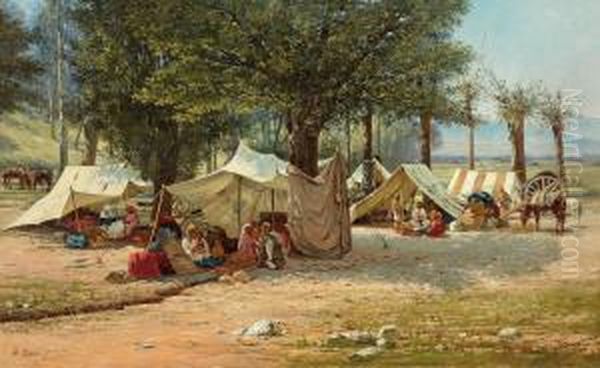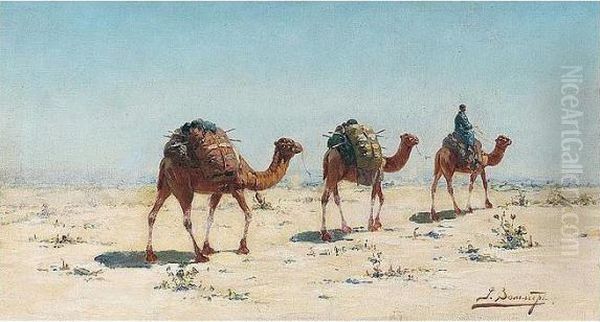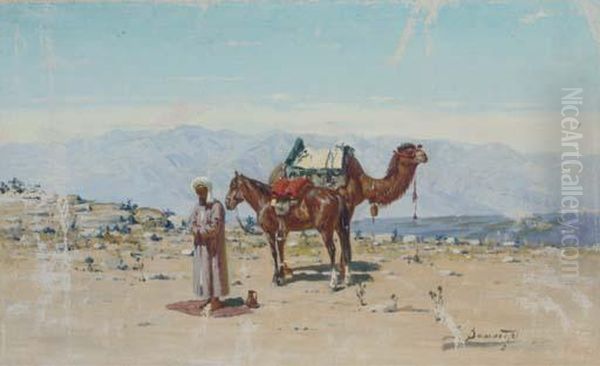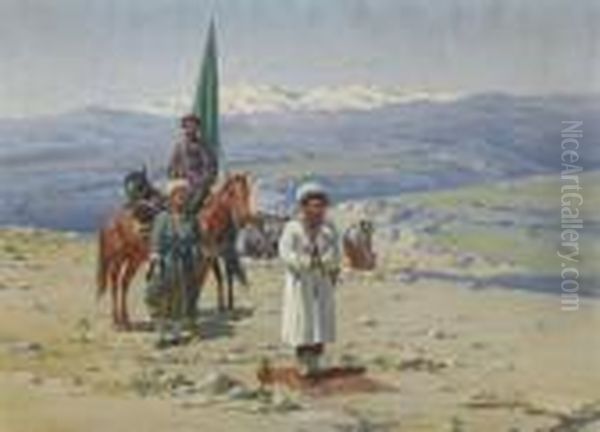Richard Karlovich Zommer stands as a significant figure in the landscape of late 19th and early 20th-century art, particularly noted for his evocative depictions of life in the Caucasus and Central Asia. Born in Munich, Germany, in 1866, Zommer's artistic path led him to Russia, where he became deeply immersed in the cultures and landscapes of the empire's southern and eastern frontiers. His life spanned a period of immense change, concluding in 1939 under challenging circumstances, likely in exile in Siberia or Kazakhstan. Zommer was not merely a painter; he was also an ethnographer and an Orientalist whose work provides a valuable window into the regions he explored.
His legacy is built upon a foundation of academic training, extensive travel, and a keen observational eye. Zommer captured the daily rhythms, architectural distinctiveness, and vibrant human tapestry of areas that were, to many Europeans, exotic and remote. His paintings serve as both artistic expressions and historical documents, preserving moments in time from cultures undergoing transformation. Through his unique blend of detailed realism and expressive color, Zommer carved a distinct niche for himself, leaving behind a body of work appreciated for its aesthetic merit and its ethnographic insight.
Early Life and Academic Foundations
Richard Zommer's artistic journey began formally within the esteemed halls of the Imperial Academy of Arts in St. Petersburg. He pursued his studies there between 1884 and 1893, a period when the Academy was a crucible for Russian artistic talent, fostering the skills of painters who would define the era. During his time at the Academy, Zommer distinguished himself, earning several awards that recognized his burgeoning talent and dedication to his craft. This rigorous academic training provided him with the technical proficiency evident throughout his career, particularly in drawing and composition.

The artistic environment in St. Petersburg during Zommer's studies was vibrant, dominated by the influence of Realism and the socially conscious themes often explored by the Peredvizhniki (Wanderers) movement. Masters like Ilya Repin and Ivan Kramskoi were leading figures, emphasizing truthful depictions of Russian life. While Zommer would later focus on different geographical regions, the Academy's emphasis on observational accuracy and technical skill undoubtedly shaped his approach. His German origins combined with his Russian education created a unique perspective, perhaps allowing him to view the diverse cultures of the Russian Empire with both an insider's access and an outsider's curiosity.
Expeditions to the East: Art and Ethnography
Following his academic training, Zommer embarked on a path that would define his artistic identity: extensive travel through the Caucasus and Central Asia. In the late 19th and early 20th centuries, he participated in significant expeditions, notably an archaeological venture into Central Asia where he served not just as an artist but also as an ethnographer. This dual role was crucial; it meant his observations were filtered through both an aesthetic sensibility and a scholarly interest in the customs, traditions, and material culture of the peoples he encountered.
His travels took him through regions like Georgia, Azerbaijan, Armenia, Uzbekistan, and possibly Kazakhstan. These areas, part of the expanding Russian Empire or within its sphere of influence, were melting pots of cultures, religions, and ethnicities. Zommer arrived during a time of transition, as traditional ways of life intersected with imperial administration and modernization. His work captures this dynamic, depicting bustling marketplaces in ancient cities like Bukhara and Samarkand, the rugged landscapes of the Caucasus mountains, and the daily existence of diverse groups, from city dwellers to nomadic tribes.
These journeys were not without their challenges. As an artist and ethnographer from a European background, Zommer would have needed to navigate significant cultural differences, language barriers, and varying social customs. The political climate in these borderland regions could also be complex and sometimes unstable. Furthermore, the physical demands of travel, especially when documenting nomadic life as seen in works like Camp of the Wanderers, would have been considerable. The snippet mentions the hardship inherent in such lifestyles, suggesting Zommer witnessed and perhaps experienced some of these difficulties firsthand.

Despite these potential obstacles, Zommer's passion for the regions shone through. His works convey a deep appreciation for the cultures he depicted. Unlike some European Orientalist painters, such as the French artist Jean-Léon Gérôme, whose depictions could sometimes veer into fantasy or stereotype, Zommer's work often feels grounded in direct observation, reflecting his ethnographic interests. He shared this focus on observed reality with Russian contemporaries like Vasily Vereshchagin, who also painted extensively in Central Asia, though Vereshchagin's work often carried a stronger anti-war message.
Artistic Style: Color, Composition, and Detail
Richard Karlovich Zommer developed a distinctive artistic style characterized by several key elements. His medium was primarily oil painting, which allowed him to achieve depth and richness in his depictions. One of the most notable features of his work is his use of color. The snippets consistently mention his preference for deep, strong, and sometimes intense colors. This vibrant palette effectively conveyed the bright sunlight, colorful textiles, and lively atmosphere of the southern and eastern regions he painted. His colors were not merely decorative; they contributed significantly to the mood and emotional impact of his scenes.
Compositionally, Zommer's works are often described as unique. He demonstrated skill in arranging figures, architectural elements, and landscape features to create balanced and engaging scenes. Whether depicting a crowded marketplace or a sparse desert landscape, his compositions guide the viewer's eye and highlight the focal points of the scene. There is often a sense of careful construction, reflecting his academic training, but also a dynamism that captures the energy of the moment.
A hallmark of Zommer's technique was his meticulous attention to detail. This is evident in his rendering of architectural features, the textures of fabrics, the physiognomy of individuals, and the specific flora or fauna of a region. This detailed approach aligns with his ethnographic interests, as it allowed him to accurately record the visual aspects of the cultures he studied. Works depicting steppe scenes or individual portraits showcase this precision. This focus on detail provides viewers with a wealth of visual information, enhancing both the realism and the documentary value of his paintings.
While detailed, Zommer's realism generally avoided overt sentimentality or excessive idealization. The snippets note a comparison with the Russian painter Genrikh Schmidt, suggesting both artists aimed for a truthful portrayal of daily life and religious practices, presenting scenes without unnecessary embellishment. This commitment to observed reality lends authenticity to his work, allowing viewers to connect with the scenes and subjects on a human level.
Themes and Representative Works

Thematically, Zommer's oeuvre revolved around the life and landscapes of the Caucasus and Central Asia. He was particularly drawn to scenes of everyday life, capturing the pulse of the regions he visited. Marketplaces were a recurring subject, offering opportunities to depict diverse crowds, vibrant commerce, and architectural backdrops. His painting Watermelon Market, likely set in Bukhara or Samarkand, is a prime example, vividly portraying the energy and color of such a scene. These market paintings resonate with the genre works of Russian artists like Pavel Fedotov or later Peredvizhniki members like Vladimir Makovsky, though Zommer's focus remained firmly on the specific cultural contexts of the East.
Nomadic life also featured prominently in his work. Paintings like Camp of the Wanderers and The Rest Camp explore the existence of tribes moving across open landscapes. These works capture both the picturesque aspects – tents pitched under wide skies, camels and horses resting – and the underlying sense of resilience and perhaps hardship associated with this way of life. Caravan in the Desert similarly addresses themes of travel and survival in challenging environments, using strong colors to depict figures and animals against stark backgrounds.
Architectural studies formed another significant part of his output. Zommer meticulously documented the distinctive buildings of the regions, from mosques and madrasas in Central Asian cities to the unique structures found in the Caucasus. These paintings serve as valuable records of architectural heritage. He also painted landscapes, capturing the dramatic mountain ranges of the Caucasus and the expansive deserts and steppes of Central Asia.
Portraits and depictions of specific figures also appear in his work. The mention of an oil painting depicting Imam Shamil, the famous 19th-century leader of Caucasian resistance against Russian expansion, indicates Zommer's interest in historical and significant local figures. Another mentioned work, At Prayer, suggests an engagement with the religious practices of the people he observed, handled with the same realistic approach seen in his secular scenes. His focus on specific cultural practices aligns him with other artists interested in the diverse peoples of the Russian Empire and beyond, such as the Armenian painter Martiros Saryan or the Russian Alexander Volkov, both known for their vibrant depictions of Eastern themes, albeit often in more modernist styles.
Connections, Mentorship, and Artistic Circles

Richard Zommer was not an isolated figure; he actively participated in the artistic life of the regions where he spent significant time, particularly in the Caucasus. One of his most important connections was with the Georgian painter Lado Gudiashvili (1896-1980). Zommer recognized Gudiashvili's talent and served as a mentor, encouraging him to pursue formal training at the Tbilisi Academy of Fine Arts. Their connection extended to exhibiting together in Tbilisi in 1926, highlighting a relationship of mutual respect and shared artistic environment. Zommer's influence thus directly contributed to the development of modern Georgian art.
Zommer was also involved in several art organizations based primarily in Tbilisi, the vibrant cultural capital of Georgia. From 1916 to 1920, he was associated with the Encouraging Society for the Development of Caucasian Decorative Arts. Subsequently, he was a member of the Artistic Society, which held exhibitions in Tbilisi (1920-21, 1923-24, 1925-26) and Baku (1921-22). His participation in these groups indicates his integration into the local art scene and his commitment to fostering artistic activity in the Caucasus. These societies likely provided platforms for interaction with other artists working in the region, potentially including figures like the self-taught Georgian master Niko Pirosmani, although their styles were vastly different.
The snippets also draw a stylistic comparison between Zommer and the Russian painter Genrikh Schmidt, particularly in their shared approach to depicting everyday life and religious subjects without excessive romanticization. This suggests Zommer was part of a broader trend within Russian and regional art that valued ethnographic accuracy and realistic portrayal. His work can also be seen in the context of other artists who engaged with Central Asian themes, such as Pavel Kuznetsov, known for his lyrical and symbolic "Kirghiz Suite" paintings, offering a stylistic counterpoint to Zommer's more grounded realism. The great Russian landscape painter Ivan Shishkin, though focused on Russian nature, represents the tradition of detailed realism from which Zommer's own meticulous approach may have partly derived.
Later Life, Exile, and Death
The later years of Richard Karlovich Zommer's life were marked by hardship, reflecting the turbulent political climate of the Soviet Union in the 1930s. As an individual of German origin living within the Soviet sphere, he became vulnerable during a period of increasing suspicion towards ethnic minorities and foreigners. The snippets indicate that in the 1930s, Zommer faced suppression from the Soviet regime, specifically targeted due to his role as a representative of the German community.

This persecution ultimately led to his forced exile. He was likely deported to Siberia or Kazakhstan, vast regions often used for internal exile and labor camps under Stalin's rule. The exact circumstances and location of his final years remain somewhat unclear, but it is known that he died in exile in 1939. This tragic end cut short the life of an artist who had dedicated much of his career to documenting the diverse cultures within the very empire, and later the state, that ultimately suppressed him. His fate mirrors that of many artists, intellectuals, and individuals deemed politically suspect during the Great Purges.
The circumstances of his death underscore the often-precarious position of artists navigating complex political landscapes. Despite the official suppression he faced, the intrinsic value of his artistic contributions could not be entirely erased. His work survived, preserved in collections and eventually re-emerging to be appreciated by later generations.
Legacy and Lasting Recognition
Despite the difficulties of his final years, Richard Karlovich Zommer left a significant and enduring legacy. His body of work stands as a rich visual archive of the Caucasus and Central Asia at a specific historical juncture. His paintings offer invaluable insights into the daily life, architecture, customs, and landscapes of these regions, captured with both artistic skill and ethnographic sensitivity. His dual perspective as a German-born, Russian-trained artist exploring the 'Orient' within the Russian sphere provides a unique viewpoint within the broader context of Orientalist art.
Zommer's influence extended beyond his own canvases. His mentorship of Lado Gudiashvili played a role in shaping the future of Georgian art. His participation in Caucasian art societies contributed to the cultural vitality of the region during his time there. Today, his works are held in prestigious museum collections, including the State Tretyakov Gallery in Moscow, the Georgian National Museum in Tbilisi, and the State Museum of Arts of Uzbekistan in Tashkent, among others. This institutional recognition affirms the artistic and historical importance of his contributions.
Furthermore, Zommer's paintings continue to attract interest in the art market. Auction results, such as the £42,000 achieved for At Prayer or the $17,000-$26,000 estimate for The Rest Camp, demonstrate the ongoing appreciation for his work among collectors. This market presence helps to keep his name and art visible to new audiences.
In conclusion, Richard Karlovich Zommer was more than just a painter of exotic scenes. He was a dedicated observer, a skilled technician, and a valuable chronicler of cultures. His deep engagement with the Caucasus and Central Asia resulted in a body of work that is both aesthetically compelling and historically significant. His paintings invite viewers to journey into the past, offering glimpses of vibrant societies and stunning landscapes through the eyes of an artist who was deeply captivated by the regions he depicted. His legacy endures in the canvases that preserve his unique vision and his contribution to the understanding of a diverse and fascinating part of the world.